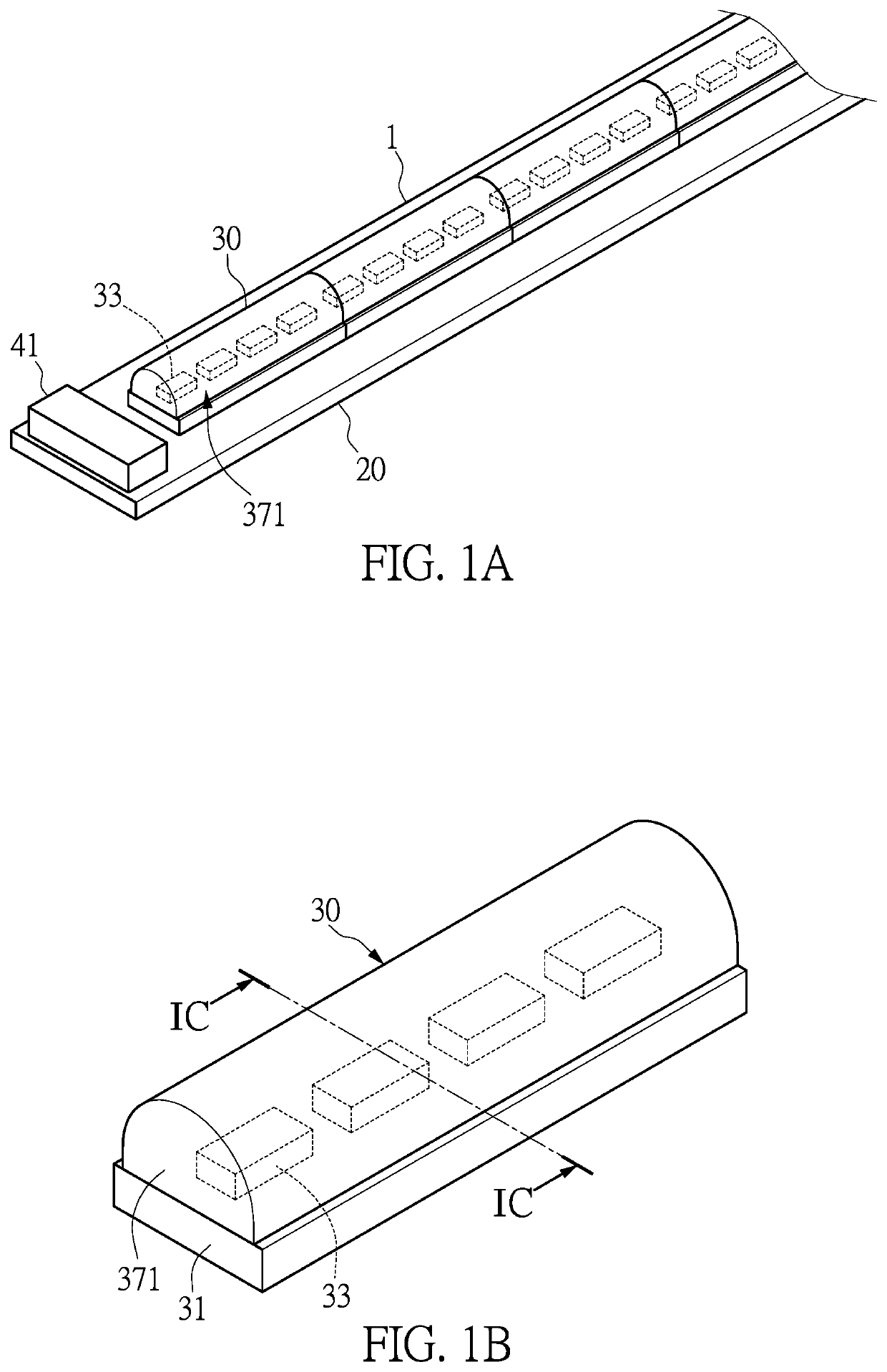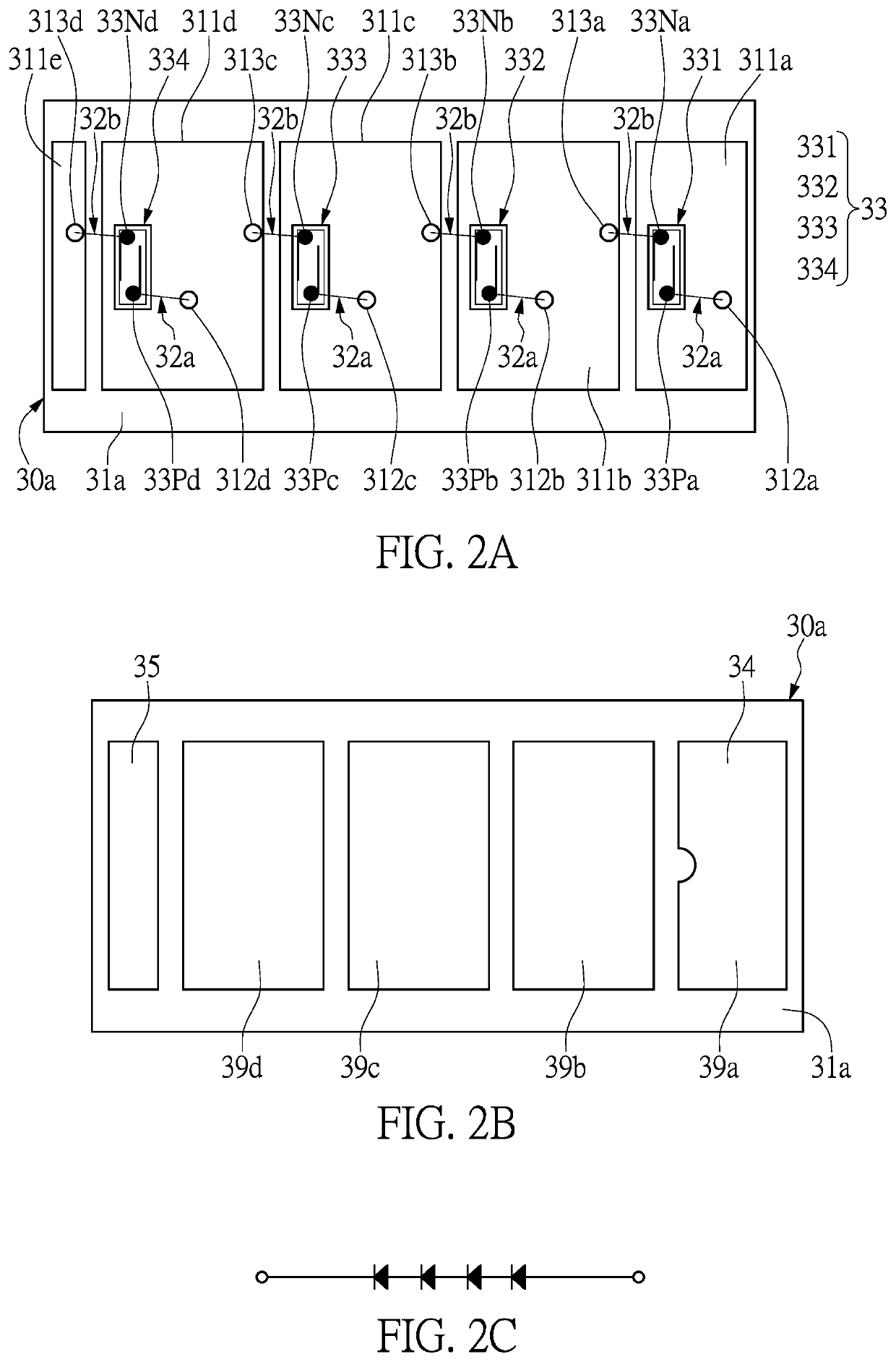Slim linear LED lighting device
a technology of led lighting and linear lamps, which is applied in the direction of semiconductor devices for light sources, elongated light sources, light and heating apparatus, etc., can solve the problems of low light utilization factor, insufficient luminous intensity, and difficulty in designing or adopting streamlined or confined space vehicular lamps
- Summary
- Abstract
- Description
- Claims
- Application Information
AI Technical Summary
Benefits of technology
Problems solved by technology
Method used
Image
Examples
second embodiment
[0041]FIG. 2A and FIG. 2B disclose the design of the substrate 31a for the LED Bar 30a of the slim linear LED lighting device 1 of the The substrate 31a consists of a designed layout (FIG. 2A) of the conductive layer on the front surface for the mounting and wire bonding (if it is necessary) of all LED chips, and another designed layout (FIG. 2B) of the conductive layer on the bottom surface for surface mounting and thermal dissipation of the LED Bar. In this embodiment, the LED Bar 30a is designed with a circuit in which four LED chips 331, 332, 333, 334 are arranged at equal pitches, and four LED chips are connected in series. The circuit symbol is as shown in FIG. 2C. The LED chips connected in series is only an embodiment, and the present invention is not limited thereto. That is, the present invention can also adopt a circuit design in which all the LED chips are electrically connected in parallel or independently, or in a mix of in series and in parallel. The LED chips 331, 3...
fifth embodiment
[0048]FIG. 9 is the slim linear LED lighting device 1c of the present invention, which comprises a printed circuit board 20c on which a plurality of LED Bars 30c, a plurality of different LED Bars 30g, a control IC (not shown in the figures), an IC for driving LED (not shown), and a connector (not shown) are provided. The LED Bar 30g contains a small number of LED chips 33 (two LED chips 33 employed in this embodiment) and has a short length. In the slim linear LED lighting device 1c of the embodiment, the printed circuit board 20c is a flexible printed circuit board (FPCB), so that the portion where the short LED Bars 30g are mounted has better bending characteristics and can be coupled with a light blade (not shown) having a portion of curved shape. The LED Bars 30c contain more LED chips 33 (four LED chips 33 employed in this embodiment), and are disposed in a portion of the slim linear LED lighting device 1c that does not need to be bent.
sixth embodiment
[0049]FIG. 10 is a slim linear LED lighting device 1d according to the present invention, comprising a printed circuit board 20d on which four LED Bars, LED Bar 30h, LED Bar 30j, LED Bar 30k and LED Bar 30p, a control IC (not shown), an IC for driving LED (not shown) and a connector (not shown) are provided. The printed circuit board 20d is an FPCB. The lengths of the LED Bar 30h, the LED Bar 30j, the LED Bar 30k and the LED Bar 30p are determined according to the design requirement, which can be equal or unequal. These four LED Bars are disposed on the flexible printed circuit board 20d at a specific pitch, so that the slim linear LED lighting device 1d of the present invention is flexible. In the application to a linear vehicular lamp made of light blade 2 having a curved outer surface, the slim linear LED lighting device 1d and the light blade 2 can be assembled in the manner as shown in FIG. 10 to achieve a better performance for photometry test. As shown in FIG. 10, the dotted ...
PUM
 Login to View More
Login to View More Abstract
Description
Claims
Application Information
 Login to View More
Login to View More - R&D
- Intellectual Property
- Life Sciences
- Materials
- Tech Scout
- Unparalleled Data Quality
- Higher Quality Content
- 60% Fewer Hallucinations
Browse by: Latest US Patents, China's latest patents, Technical Efficacy Thesaurus, Application Domain, Technology Topic, Popular Technical Reports.
© 2025 PatSnap. All rights reserved.Legal|Privacy policy|Modern Slavery Act Transparency Statement|Sitemap|About US| Contact US: help@patsnap.com



